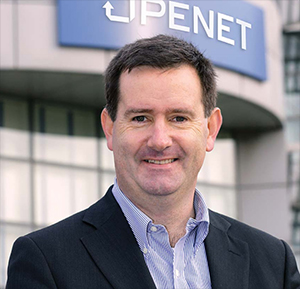Communications service providers (CSPs) need to move from a mentality of saving costs to one of creating new sources of revenue. Those can come from effective use of CSP data, greater exploitation of the customer relationship and improved agility and flexibility to introduce new services over virtualised networks, Joe Hogan, the founder and chief technology officer of Openet, tells VanillaPlus.
VanillaPlus: Every day we see CSPs cutting prices and increasing data volumes in bundles. Does this signify a race to the bottom and the commoditisation of data? If so, how can CSPs move from a commodity model to selling based on value?

Joe Hogan: The race to the bottom is happening among CSPs that are in danger of commoditising data if they just sell data as a product. Every week we see another CSP announce data increases in their basic bundles and associated price cuts. This is fine if you’ve got a new source of revenue to compensate for the loss but if you don’t, then there is a real danger that data could be commoditised.
We are seeing CSPs develop new revenue sources – from selling more products and services to looking at new business models. Working with content partners and upselling television, entertainment and music services, for example, is happening. Also providing better direct customer engagement is helping boost revenues, such as from selling roaming passes or add-ons. Either a data block at the end of the month, or a content upsell is helping augment the fixed monthly data bundle revenues.
BSS needs to enable CSPs to rapidly develop, launch and monetise new offers – this is often not possible with service heavy legacy systems. BSS needs to be all real-time, have a centralised offer catalogue that can enable fast time to market for many, many more offers.
VP: With free Wi-Fi becoming increasingly widespread and reports that between 60-70% of mobile data traffic currently being carried by WiFi, is there a danger that CSPs could even lose out in the fight for basic connectivity? How can they better harness Wi-Fi to their advantage?
JH: The importance of Wi-Fi is increasing. Just look at the connectivity models for Google’s Project Fi. It’ll be Wi-Fi connectivity where possible and then LTE as a fallback. As long as the quality is good customers probably don’t know and don’t care over what technology their mobile data is going. The key point here is that the customer will be happy as long as the quality is good. CSPs are selling high-speed LTE services, people are watching television on their devices so the network experience must be good otherwise customer will turn off.
In order to deliver the type of network experience customers expect there is a role to play for network selection intelligence. This is a combination of ANDSF (access network detection and selection function) and policy management. This not only identifies available Wi-Fi hotspots for offloading data traffic to but also can measure the quality of the Wi-Fi hotspot and also set the rules as to what traffic goes to Wi-Fi and what stays on LTE. This could mean video traffic for some types of customers on certain devices gets offloaded, for example.
The cost saving implications of using Wi-Fi are huge but in order to take full advantage, CSPs need to ensure that they’re delivering the quality of services that customers expect. The impact on BSS is that as CSPs look at multiple access methods – LTE, LTE-U and Wi-Fi there does need to be a capability to extend policy to the device to ensure the customer network experience is as expected.
In many cases CSPs are losing out to free Wi-Fi. Some prepaid customers top up infrequently and then don’t even bother switching mobile data on. They use public and free Wi-Fi. CSPs are offering service passes that stress the convenience of cellular data as well as low cost.
For example, we see CSPs in some countries offer a one-day, 50MB data pass. We’ve also seen application service passes where CSPs offer a service pass for WhatsApp. This is low cost and allows only the use of WhatsApp. We’ve seen this in countries with a large migrant workforce that uses WhatsApp to call their family back home. Here the CSPs stressed the low cost and convenience of WhatsApp service pass, as opposed to walking around shopping malls or public libraries trying to get free Wi-Fi.
VP: One of the main assets that CSPs have is their customer base but when you compare the level of engagement a CSP has with its customers, compared to a say, Facebook or LinkedIn, there’s no comparison. Is it fair to say that CSPs are not engaging with their customer base and therefore are at risk of ignoring their most valuable asset?
JH: Yes, a CSP’s customer base is their most important asset, but they have to ask some very hard questions of how relevant they are to their customer base and measure themselves against the competition. In this case competition can be the digital service providers such as Google, Facebook or LinkedIn. These companies engage with mobile customers day in, day out and, more importantly, customers engage with them. The main reason is relevance. On the whole most CSPs don’t really engage that much with their customers. Many customers just get a bill emailed to them once a month, and some don’t even open the email. If they’re lucky they’ll get a call from a call centre once a year asking them if they’re happy with the service. The level of engagement is not great. Which is strange as CSPs have the data that can drive meaningful, personalised and relevant customer engagement.
For example, a subscriber spends a lot of time streaming music to their phone – perhaps they’d like to try a free month of Spotify premium? BSS needs to be able to drive real-time, relevant customer engagement – from upselling a new service to providing a customer notification on a loyalty offer. CSPs already have the data in their systems – the key is harnessing this data and turning it into relevant and timely intelligence to drive customer engagement.
VP: We hear about BSS moving to all real-time, but what about functions like business intelligence? These have traditionally used historical data to build a view of customers. Is there an opportunity for real-time network and usage data to enhance business intelligence?
JH: As BSS moves towards all real-time so does the opportunity to use the data collected for deeper analytics and to drive customer offers. BSS collects data on customer behaviour and usage in real-time and this is passed to a data warehouse where it can be used to provide historical business intelligence, such as churn propensity score, lifetime value, net promoter score and customer experience indicators. However, while data warehouses provide a good historical view of customer behaviour, they don’t provide a picture of what’s happening here and now. This why streaming analytics is being used on real-time data so that it can also be used to provide a real-time trigger, along with the historical customer business intelligence, to activate context-aware offers. The problem is not all CSPs are providing real-time context-aware offers, so many are missing out on additional revenue streams. Traditional upsell offers are not real-time; they are usually based on pre-planned schedules or off-line processing based on historic activity.
Whilst CSPs continue to create innovative data services to generate more revenue, they may not be maximising their revenue potential with traditional upsell approaches. Every time there is an opportunity to upsell, CSPs should be able to do so. This means having the capability to take into account the real-time and historical customer context to send the most suitable offers to their device in real-time; customers should then be able to purchase and activate the services instantly. The context can be based on a combination of historical and real-time data including the subscriber activity, usage, application accessed, location, profile and more. By enabling such real-time contextual offers, CSPs can maximise upsell opportunities and the chances of uptake by customers as they receive the most relevant offers at the most opportune time. In a recent survey of 87 operators by Openet, respondents indicated that they could increase offer uptake rates by 75% and data revenues by 15% if they could deliver real-time contextual offers.
VP: CSPs are reducing their network and IT capex and opex budgets. Does this make them more vulnerable, or is this a result of new dawn of agility and implementation of NFV and SDN?
JH: Reduction of capex and opex budgets are all part of CSPs becoming leaner and more agile organisations. SDN (software defined networking) and NFV (network functions virtualisation) are playing a major role here. CSPs are looking to turn up services in minutes rather than months. With CSPs looking at NFV it’s important to examine how NFV impacts BSS. Many CSPs’ existing network operations models and OSS/BSS systems are not prepared for emerging new technologies like NFV.
New thinking is required on how legacy OSS/BSS systems will need to evolve in order to support NFV. Simply extending existing OSS/BSS models to account for virtualisation will not be sufficient, because this approach will not support the new value-added capabilities and services provided by NFV. In addition, there is also the need for real-time processing of a huge amount of data, including data analytics, based on several data sources. Structured and unstructured data from the infrastructure is a further key challenge in the OSS/BSS and NFV context.
On its own, network functions virtualisation is not enough. NFV concepts need to be applied in the OSS/BSS to deliver on the promises of NFV such as agility, reduced total cost of ownership, increased elasticity and greater service availability. This is particularly important for policy and charging functions. There is little point in having a dynamic network if the monetising, access control, and revenue handling systems are not similarly endowed.
The nirvana, which is five to ten years away, is running NFV over SDN and that is where the capex and opex reductions will really become significant. It will come in steps but if you’re just hacking away at budgets you won’t get the agility you need to stay in business. I don’t think you can save your way to greatness.






